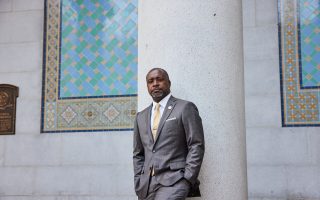The internet’s favorite catalog of weird places rewrites history

Samir S. Patel found us a parking spot on Madison Avenue and 103rd Street before it started raining last Wednesday, and led me under scaffolding into the grand lobby of the New York Academy of Medicine. There, a librarian, pleased to be giving her first tour in more than a year, took us down a long hallway into a room lined with rare books from the 16th and 17th centuries that she opened to show eerie anatomical renderings of humans without their skin.
The librarian, Arlene Shaner, had left a small box sitting on the table, and opened it last. Inside was a jaw and some teeth – lower jaw dentures that had once belonged to President George Washington. His dentist had proudly inscribed on the gumline, “This was Great Washington’s teeth.”
The visit to a little-known and macabre piece of history is very much in the spirit of Atlas Obscura, the 11-year-old website where Patel is the editorial director. But he was also there to point out something else about Washington’s dentures: They include six real teeth, which may have been purchased from poor New Yorkers or taken from people Washington held in slavery. That detail adds a layer of darkness to what would otherwise be a mere historical curiosity.
Patel, a trim, bearded science journalist, and his team have just completed the first stage of what Atlas Obscura calls its “decolonization project” – a review of some of the 20,000 entries from a database, compiled by its community and staff, of curious places around the world in light of the last year’s shift in how Americans view their history. The team has now woven the Sioux perspective into a description of a battle in Colorado in the “Indian Wars” and explored the 20th century details of inhumane treatment at the sort of eerie abandoned mental hospitals that attract curious visitors.
“There’s an entire hidden history that underlies the world that we don’t get told about when we travel,” he said.
There’s a lot of talk in the media about wrestling with questions of race and power and perspective at a moment of shifting cultural and political values. Academic jargon like “decolonization” sometimes gets thrown around in that context.
In travel writing, it’s a bit more literal. The whole genre has at least some of its origins in 19th century gentleman explorers in pith helmets gawking at Indigenous people. Atlas Obscura itself draws half-seriously on a European history that predates even pith helmets. It’s centered on an obscure 17th century German Jesuit scholar named Athanasius Kircher, whom Joshua Foer, one of Atlas Obscura’s founders, reveres for his sense of wonder at the world. Foer once wrote a blog called The Proceedings of the Athanasius Kircher Society and met his co-founder, Dylan Thuras, at the first and only meeting of that society.
When the pandemic hit last spring, Atlas Obscura had just received a $20 million investment from a group of investors led by Airbnb. Atlas Obscura, at the time, was focused on building the “experience” side of its business – guided tours and classes – which it expected to snap into the giant home rental platform. (The New York Times is also an investor in Atlas Obscura.) But Airbnb gave up on the initiative as it scrambled to weather the crisis. And like the rest of travel media, Atlas Obscura has spent a year mostly catering to the fantasies of homebound travelers. That led, the company says, to record traffic and advertising revenue, as well as a new business in online classes.
Now, the travel media and the travel industry are bracing – and hoping – for a surge of tourism. Though few in the travel media have taken on reediting of their product like Atlas Obscura, they’re also trying to adapt to a changed political situation, seeking to find nonwhite writers who live in the places they write about, or to have more diverse American writers tell the stories of destinations. Jacqueline Gifford, the editor-in-chief of Travel and Leisure, said the travel media was trying to ask itself, “Who gets to tell travel stories, why they’re telling them, and what’s the way we can be more representative of this country, of the world we’re living in today?”
But there are also built-in limits to how much you can revolutionize travel writing, said Rafat Ali, the founder of the travel business site Skift.
“It’s always going to be outsiders looking in,” he said.
The challenge for editors and writers across media is how to make journalism inclusive as well as riveting and provocative, rather than just a corporate media exercise in box-checking. (One top newspaper editor described that genre to me last week as “DEI dutiful,” referring to diversity, equity and inclusion initiatives.)
It shouldn’t be that hard. Complicated, surprising stories are often the best ones, as illustrated by the superb “Reckoning With a Reckoning” issue that Adrienne Green, the features editor at New York magazine, put together last week. It sought, as the magazine’s editor-in-chief, David Haskell, wrote in an email, “to clarify stakes and also complicate them, to tell morality tales but avoid easy morals.”
Atlas Obscura, which also publishes magaziney features like the disturbing story of how a Black woman’s remains wound up on display at a Philadelphia museum and the secret queer history of Colonial Williamsburg, is another good example of how a publisher can meet the moment by deepening its content with an inquiry into, in particular, the violence Americans often choose to forget.
Indeed, Patel told me he’s not sure “decolonizing” was the right word for the project. “Decolonization suggests removal, and that’s not what we’re doing,” he said Wednesday morning, as we began our tour of unusual New York sites on the edge of the Bushwick section of Brooklyn. “Adding this kind of perspective to travel and travel writing makes it less boring.”
Then he called a Times photographer to confirm our destination, “at a dead end that leads to something weird.” (He wouldn’t say anything about our destinations in advance, in keeping with the Atlas Obscura vibe.)
We turned past a genial group of people seated on folding chairs in the middle of Central Avenue, under a haze of marijuana smoke, and into a sprawling cemetery where German and Czech Catholics are buried under hollow metal tombstones, a classically morbid Atlas Obscura site, before pulling out for the long drive to the Upper East Side.
After contemplating George Washington’s dentures and the other treasures of the New York Academy of Medicine, we headed to the northern tip of Manhattan, where Patel parked his blue Nissan by Inwood Hill Park and emerged into a thunderstorm.
“I didn’t think the rock was this far into the park,” he said, furrowing his brow at the map on a beta version of Atlas Obscura’s app, as we trudged past a dozen men playing soccer in the rain.
A few minutes later, we were standing in front of a big rock whose plaque offers the pat and familiar story about how Peter Minuit bought Manhattan for the Dutch from its Native American inhabitants in exchange for some glass beads.
This spring, Atlas Obscura added to its own write-up, explaining what historians now believe the inhabitants thought they were doing: trading a nonexclusive right to use the land, not selling it. There were, it notes dryly, “differing concepts of ownership” between the Lenape and the Dutch.
“The classic story is that it was bought for a handful of trinkets,” Patel said, “but I think this is more interesting.”
[This article originally appeared in The New York Times.]






